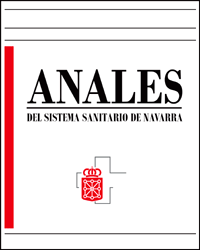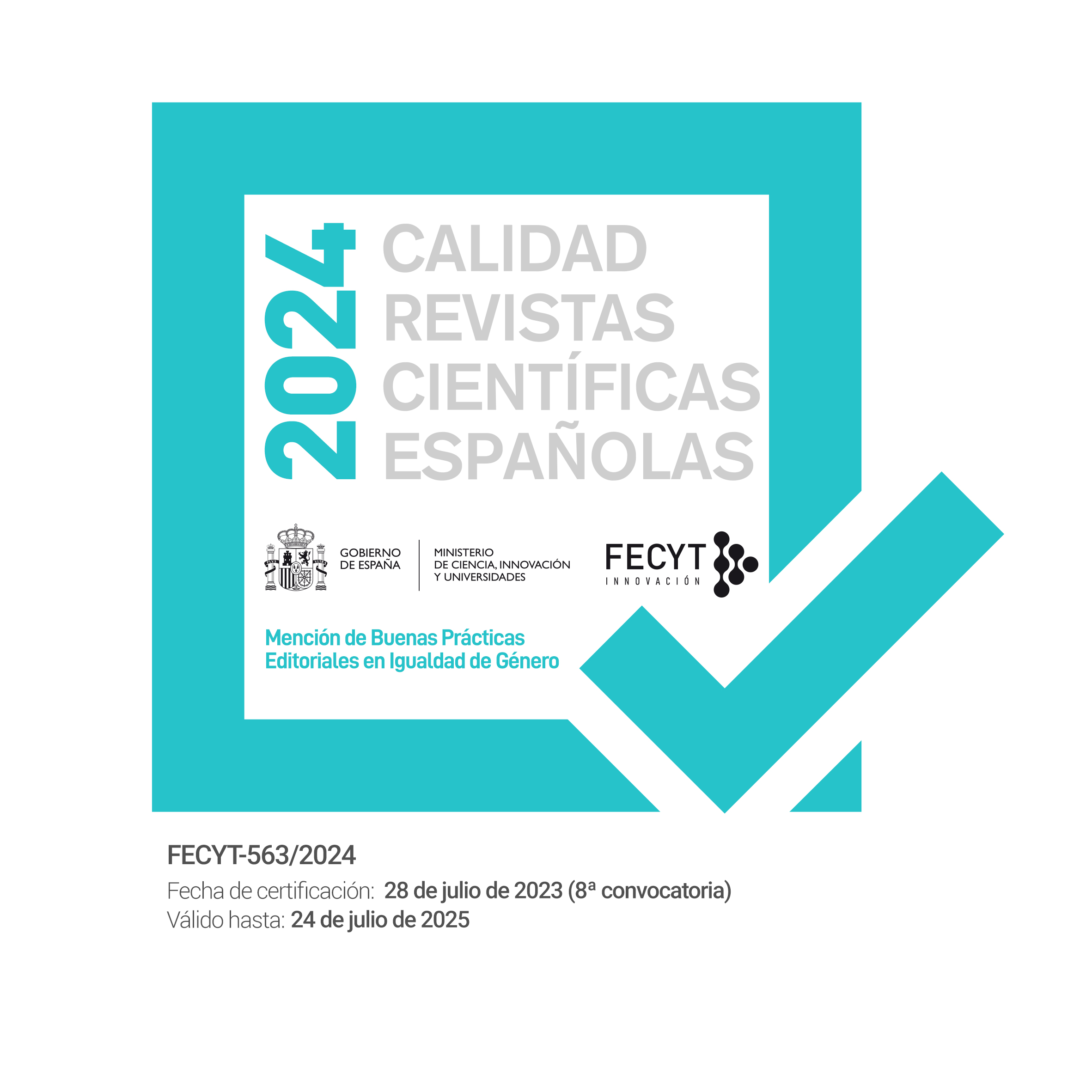Factores del entorno de trabajo que influyen en la ocurrencia de errores de administración de medicación
Palabras clave:
Seguridad del paciente. Error de medicación. Administración de medicación. Entorno de las instalaciones sanitarias.Resumen
Fundamento. La incidencia de errores de administración de medicación (EAM) es alta y costosa para pacientes e instituciones sanitarias. En su ocurrencia intervienen factores humanos y del entorno de trabajo. El objetivo de este trabajo es identificar los factores del entorno de trabajo que se relacionan con la ocurrencia de EAMs en el ámbito hospitalario.
Metodología. Se llevó a cabo una revisión narrativa de la literatura. Se incluyeron 8 artículos tras revisar las bases de datos MEDLINE, CINAHL y COCHRANE LIBRARY, durante el periodo 2002-2012.
Resultados. Las distracciones e interrupciones, la sobrecarga de trabajo, el diseño de las unidades y las características del material han sido destacados entre los factores del entorno de trabajo que intervienen en la ocurrencia de errores de administración de medicación.
Conclusiones. La creación de artefactos organizacionales para reducir las interrupciones; la implicación del paciente en la administración de medicación; la introducción de nuevas tecnologías y la mejora del etiquetado de los medicamentos puede ayudar a reducir la incidencia de errores de administración de medicación. Para avanzar en la identificación y gestión de factores precursores de errores de administración de medicación se recomienda la realización de estudios de cohortes prospectivas o revisiones.Descargas
Citas
1. FERNER RE, ARONSON JK. Clarification of terminology in medication errors: definitions and classification. Drug Saf 2006; 29: 1011-1022.
https://doi.org/10.2165/00002018-200629110-00001
2. BRADY AM, MALONE AM, FLEMING S. A literature review of the individual and systems factors that contribute to medication errors in nursing practice. J Nurs Manag 2009; 17: 679-697.
https://doi.org/10.1111/j.1365-2834.2009.00995.x
3. OTERO MJ. Errores de medicación y gestión de riesgos. Rev Esp Salud Pública 2003; 77: 527-540.
https://doi.org/10.1590/S1135-57272003000500003
4. Estudio Nacional sobre los Efectos Adversos ligados a la hospitalización: ENEAS 2005. Ministerio de Sanidad y Consumo. Madrid: 2006.
5. CLARK PA. Medication errors in family practice, in hospitals and after discharge from the hospital: an ethical analysis. J Law Med Ethics 2004; 32: 349-357.
https://doi.org/10.1111/j.1748-720X.2004.tb00481.x
6. National Patient Safety Agency [revista electrónica], 2012. [Consultado 04-06-2012]: Disponible en http://www.npsa.nhs.uk.
7. KOHN LT, CORRIGAN JM, DONALDSON MS. To Err is Human: Building a Safer Health System Institute of Medicine. National Academy Press, 1999.
8. OTERO MJ, ALONSO P, MARTÍN R, VALVERDE MP, DOMÍNGUEZ A. Analysis of preventable adverse drug events (ADEs) leading to hospital admission: incidence, categorization and cost. 36th ASHP Midyear Clinical Meeting and Exhibits, December 2-6, 2001. New Orleans (LA).
9. DENNISON RD. Creating an organizational culture for medication safety. Nurs Clin North Am 2005; 40: 1-23.
https://doi.org/10.1016/j.cnur.2004.10.001
10. Revisión Bibliográfica sobre Trabajo de Costes de la "No Seguridad del Paciente". Ministerio de Sanidad y Consumo. Madrid: 2008.
11. Australian Council for Safety and Quality in Healthcare. Second national report on patient safety: improving medication safety 2002. [Consultado 04-06-2012]. Disponible en http://www.safetyandquality.gov.au.
12. STETINA P, GROVES M, PAFFORD L. Managing medication errors: A qualitative study. Medsurg Nurs 2005; 14: 174-178.
13. ARMITAGE G, KNAPHAM H. Adverse events in drug administration: a literature review. J Nurs MANAG 2003; 11: 130-140.
https://doi.org/10.1046/j.1365-2834.2003.00359.x
14. REASON JT. Understanding adverse events: human factors. Qual Health Care 1995; 4: 31-54.
https://doi.org/10.1136/qshc.4.2.80
15. REASON JT. Human error: models and management. BMJ 2000; 320: 768-796.
https://doi.org/10.1136/bmj.320.7237.768
16. REASON JT. Human error. Cambridge University Press, 1990.
https://doi.org/10.1017/CBO9781139062367
17. VINCENT C, STANHOPE N, CROWLEY-MURPHY M. Reasons for not reporting adverse events: an empirical study. J Eval Clin Pract 1999; 5: 13-21.
https://doi.org/10.1046/j.1365-2753.1999.00147.x
18. NORMAN DA. The Psychology of everyday things. Basic Books, 1998
19. KELLOWAY EK, DAY AL. Building healthy workplaces: What we know so far. Can J Behavioural Science 2005; 37: 223-235.
https://doi.org/10.1037/h0087259
20. CARLTON G, BLEGEN MA. Medication-related errors: a literature review of incidence and antecedents. Annu Rev Nurs Res 2006; 24: 19-38.
https://doi.org/10.1891/0739-6686.24.1.19
21. POPESCU A, CURREY J, BOTTI M. Multifactorial Influences on and Deviations from Medication Administration Safety and Quality in the Acute Medical/Surgical Context. Worldviews Evid Based Nurs 2011; 8: 15-24.
https://doi.org/10.1111/j.1741-6787.2010.00212.x
22. AACN, Standards for Establishing and Sustaining Healthy Work Environments. American Association of Critical-Care Nurses 2005. [Consultado 04-06-2012]. Disponible en http://www.aacn.org.
23. BENNET J, DAWOUD D, MABEN J. Effects of interruptions to nurses during medication administration. Nurs Manag 2010; 16: 22-23.
https://doi.org/10.7748/nm2010.02.16.9.22.c7522
24. ESI OWUSU R, WHILE A. Medication errors: types, causes and impact on nursing practice. Br J Nurs 2010; 19: 380-385.
https://doi.org/10.12968/bjon.2010.19.6.47237
25. FRY MM, DACEY C. Factors contributing to incidents in medicine administration. Part 1. Br J Nurs 2007; 16: 556-558.
https://doi.org/10.12968/bjon.2007.16.9.23435
26. MCBRIDE-HENRY K, FOUREUR M. Medication administration errors: understanding the issues. Aust J Adv Nurs 2006; 23: 33-41.
https://doi.org/10.37464/2006.233.1933
27. TISSOT E, CORNETT C, LIMAT S, MOURAND JL, BECKER M, ETIEVENT JP et al. Observational study of potential risk factors of medication administration errors. Pharm World and Sci 2003; 25: 264-268.
https://doi.org/10.1023/B:PHAR.0000006519.44483.a0
28. TAXIS K, BARBER N. Causes of intravenous medication errors: an ethnographic study. Qual Saf Health Care 2003; 12: 343-348.
https://doi.org/10.1136/qhc.12.5.343
29. MAYO AM, DUNCAN D. Nurse perceptions of medication errors: what we need to know for patient safety. J Nurs Care Qual 2004; 19: 209-217.
https://doi.org/10.1097/00001786-200407000-00007
30. DEANS, C. Medication errors and professional practice of registered nurses. Collegian 2005; 12: 29-33.
https://doi.org/10.1016/S1322-7696(08)60480-1
31. WESTBROOK JL, WOOD A, ROB MI, DUNSMUIR WTM, DAY RO. Association of interruptions with an increased risk and severity of medication administration errors. Arch Intern Med 2010; 170: 683-690.
https://doi.org/10.1001/archinternmed.2010.65
32. PAPE TM, GUERRA DM, MUZQUIZ M, BRYANT JB, INGRAM M, SCHRANNER B et al. Innovative Approaches to reducing nurses' distractions during medication administration. J Contin Educ Nurs 2005; 36: 108-116.
https://doi.org/10.3928/0022-0124-20050501-08
33. EBRIGHT P, PATTERSON E, CHALKO B, RENDER M, MARTER L. Understanding the complexity of registered nurse work in acute care settings. J Nurs Adm 2003; 33: 630-638.
https://doi.org/10.1097/00005110-200312000-00004
34. MYNY D, VAN HECKE A, DE BACQUER D, VERHAEGHE S, GOBERT M, DEFLOOR T et al. Determining a set of measurable and relevant factors affecting nursing workload in the acute care hospital setting: A cross-sectional study. Int J Nurs Stud 2012; 49: 427-436.
https://doi.org/10.1016/j.ijnurstu.2011.10.005
35. BRUSH K. Upgrading systems design to reduce medication administration errors. Clin Nurse Spec 2003; 17: 15-16.
https://doi.org/10.1097/00002800-200301000-00013
36. BENNET J, HARPER-FEMSON L, TONE J, RAJMOHAMED Y. Improving medication administration systems: An evaluation study. Can Nurse 2006; 102: 35-39.
37. POTTER PL, WOLF L, BOXERMAN S. Understanding the cognitive work of nursing in the acute care environment. J Nurs Adm 2005; 35: 327-335.
https://doi.org/10.1097/00005110-200507000-00004
38. RATHMANN KL, MEADOWS L, SIMPSON K. Creation of a "Patient Safety Zone" to reduce pharmacy and nursing distractions and improve patient care. 2007; 42: 2-6.
39. PALESE A, SARTOR A, COSTAPERARIA G, BRESADOLA V. Interruptions during nurses' rounds in surgical wards: Observational study. J Nurs Manag 2009; 17: 185-192.
https://doi.org/10.1111/j.1365-2934.2007.00835.x
40. POON EG, KEOHANE CA, YOON CS, DITMORE M, BANE A, LEVTZION-KORACH O et al. Effect of bar-code technology on the safety of medication administration. N Engl J Med 2010; 362: 1698-1707.
https://doi.org/10.1056/NEJMsa0907115
41. MCROBERTS S. The use of bar code technology in medication administration. Clin Nurse Spec 2005; 19: 55-56.
https://doi.org/10.1097/00002800-200503000-00003
42. ENGLEBRIGHT JD, FRANKLIN M. Managing a new medication administration process. JONA 2005; 35: 410-413.
https://doi.org/10.1097/00005110-200509000-00011
43. PERRY S, THAMER M. Medical innovation and the critical role of health technology assessment. JAMA 1999; 282: 1869-1872.
https://doi.org/10.1001/jama.282.19.1869
44. MCCOY LK. Look-alike, sound-alike, drugs review: include look-alike packaging as an additional safety check. Jt Comm J Qual Patient Saf 2005; 31: 47-53.
https://doi.org/10.1016/S1553-7250(05)31007-5
45. SCHULMEISTER L. Look-alike, sound-alike oncology medications. Clin J Oncol Nurs 2005; 10: 35-41.
https://doi.org/10.1188/06.CJON.35-41
46. BERMAN A. Reducing medication errors through naming, labeling, and packaging. J Med Syst 2004; 28: 9-29.
https://doi.org/10.1023/B:JOMS.0000021518.60670.10
47. AIBAR-REMÓN C. El conocimiento del riesgo asistencial: ¿qué pueden aportar los pacientes? An Sist Sanit Navar 2012; 35: 5-8.
https://doi.org/10.4321/S1137-66272012000100001
48. MIRA JJ, VITALLER J, LORENZO S, ROYUELA C, PÉREZ-JOVER V, ARANAZ J. Pacientes como informadores de eventos adversos. Resultados en diabetes y enfermedad renal. An Sist Sanit Navar 2012; 35: 19-28.
https://doi.org/10.4321/S1137-66272012000100003
49. KHUN AM, YOUNGBERG BJ. The need for risk management to evolve to assure a culture of safety. Qual Saf Health Care 2002; 11: 158-162.
https://doi.org/10.1136/qhc.11.2.158
50. LOZANO JM. De patos, gansos y cisnes. Revisiones narrativas, revisiones sistemáticas y meta-análisis de la literatura. Redalyc 2005; 30: 1-3.
51. ANTMAN EM, LAU J, KUPELNICK B, MOSTELLER F, CHALMERS, TC. A comparison of results of meta-analyses of randomized control trials and recommendations of clinical experts. JAMA 1992; 268: 240-248.
https://doi.org/10.1001/jama.1992.03490020088036
52. COLLINS JA, FAUSER B. Balancing the strengths of systematic and narrative reviews. Human Reproduction Update 2005; 11: 103-104.
Publicado
Cómo citar
Número
Sección
Licencia
Derechos de autor 2013 Anales del Sistema Sanitario de Navarra

Esta obra está bajo una licencia internacional Creative Commons Atribución-CompartirIgual 4.0.
La revista Anales del Sistema Sanitario de Navarra es publicada por el Departamento de Salud del Gobierno de Navarra (España), quien conserva los derechos patrimoniales (copyright ) sobre el artículo publicado y favorece y permite la difusión del mismo bajo licencia Creative Commons Reconocimiento-CompartirIgual 4.0 Internacional (CC BY-SA 4.0). Esta licencia permite copiar, usar, difundir, transmitir y exponer públicamente el artículo, siempre que siempre que se cite la autoría y la publicación inicial en Anales del Sistema Sanitario de Navarra, y se distinga la existencia de esta licencia de uso.








